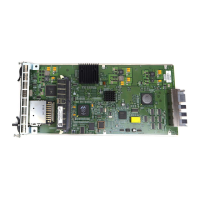162 Brocade MLXe Series Hardware Installation Guide
53-1003030-01
Managing switch fabric modules
5
Monitor/Application Image Mismatch
A version mismatch between the monitor and application image results in system failure. The
Rolling Reboot feature places the line card into the interactive or down state mode on detection of
a monitor and application image version mismatch.
Line Module Configuration Deletion in Interactive Boot Mode
In this release, line module configurations can be deleted when a module is in Interactive Boot
Mode. When an existing LP module is removed from the slot and replaced by an LP module of a
different configuration, the LP module boots up to Interactive Boot Mode due to a configuration
mismatch. The LP module configuration is not allowed to be removed or updated without manual
removal of the LP module.
To avoid physically removing the LP module from the slot and deleting or updating the LP module
configuration, the deletion of the LP module configuration is only allowed if the card is in Interactive
Boot Mode. The LP module needs a power cycle to return to the Up state. On execution of the “No
Module” command, the user is prompted with an option to power cycle the card.
Managing switch fabric modules
This section provides information about how to manage standard switch fabric modules and high
speed switch fabric modules.
In CLI output, standard modules are referred to as generation 1 (G1) modules, and high-speed
modules are referred to as generation 2 (G2) modules. The following interface modules are
classified by the system as G2 modules: 8x10G, 100G modules. All other interface modules such as
4-port 10G, 2-port 10G, 20-port 1G, 24-port 1G, and 48-port 1G modules are classified by the
system as G1 modules.
High speed switch fabric (HSF) modules can operate in Normal mode or Turbo mode. Standard
switch fabric modules (SFM) can only operate in Normal mode. The HSF module is classified as a
G2 module and SFM module is classified as a G1 module.
When operating in Normal mode, the system uses fixed size cells across the backplane. When
operating in Turbo mode, the system uses variable size cells across the backplane. Turbo mode
provides higher performance since it is a more efficient mechanism of sending cells across the
backplane.
The system selects the operating mode for switch fabric modules at startup, or when the first
switch fabric or interface module is installed. The system uses this mode for all modules that are
subsequently installed. HSF modules will boot in Turbo mode only if all active interface modules are
G2 modules. In a chassis loaded with G1 and G2 modules, the HSF modules will default to Normal
mode.
If a system is operating in Turbo mode, G1 interface modules are blocked from operation. The user
has to change the switch fabric mode to Normal mode and restart the system before using the G1
interface modules.
If the system fabric mode is changed to Normal mode from Turbo mode, or vice versa, the system
will not change the current operating mode unless the chassis is reloaded.

